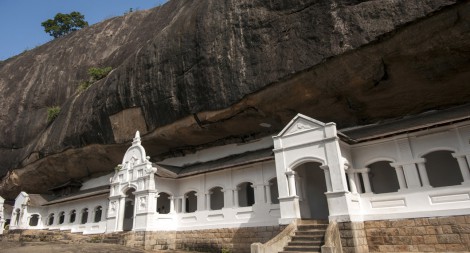Dambulla is a small town connecting between Kandy and Anuradhapra. The Dambulla’s cave is located on top of a rock also called “Ran Giri” means shinnying like a gold, was constructed by curving a natural cave. It is the largest and the best preserved cave temple in Sri Lanka. It consists of five caves and stunning colorful wall paintings and numbers of Buddhist statue are displayed inside. These paintings represent stories of Lord Buddha and his life.
It was originally constructed by Sinhalese King Valagambahu in 1st century BC. The King was exiled from Anuradhapra by Tamil military and he was planning to take over the power while he was hiding in Dambulla. Later, he won over the power again and created a temple here, in order to show his gratitude to Lord Buddha. The number of mural paintings and Buddhist statues increased over the years. This site was reconstructed during Polonnaruwa and Kandy periods by those kings.

Temple with historic value and the shinning wall paintings
You go through a long stairs by the left side of Big Buddha for about 20 minutes to get to the cave temple.
Dava Raja Vihara, the first cave:
It means “King of gods temple”. This is the oldest cave and has the largest Buddhist statue with 14 m in size. The statue is curved from the same natural stone from the cave. The body is covered with gold, but the back of feet is red in which was derived from the time when King Vijaya arrived from India in 5 B.C., his hands were red. There is a Hindu Temple next to the Buddhist temple.
Maha Raja Vihara, the second cave:
It means “The great King’s temple”. The King is referring to Vattagamini Abhaya. His status is displayed inside. This is the largest cave with approx.52m width, 25m length, 6m high. There are 56 statues and stunning wall paintings that tell the life story of Buddha and the history of Sri Lanka. There is also natural spring water dropping from the center of celling. Dambulla means the rock with spring water, thus the name is coming from this second cave.
Maha Alut Vihara, the third cave:
It means “The great new temple”.It was constructed by King Kirti Sri Rajasinha in the late 18th century. 57 Buddha statues and a 9m sleeping Buddha are stored.
Pachima Vihara, the fourth cave:
It means “ Three Kind’s Temple”. It was constructed the end of Kandy dynasty. The Buddhist statues are comparatively here.
Devana Alut Vihara, the fifth cave:
This is the newest one constructed in 1915
Entrance fee: Rs.1,500
Hours: 7am - 5pm